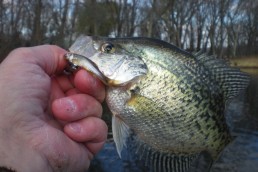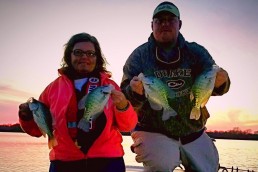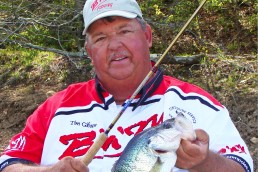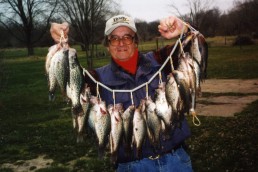Get the Jump on April Crappies
SHARE THIS POST
When someone takes the time to tell you they’re giving you “sound advice,” it’s usually time for you to prepare yourself for a 20-minute spiel. But in reality, sound advice doesn’t have to take that long. Horace Greeley was pretty succinct when he famously gave advice saying, “Go West, young man.” If I had to pass on advice for catching early-season crappies, I’d be able to give old Horace a pat on the back for his brevity. And, I’d tell you to “Go early, young man.”
Crappies are panfish, and act like other panfish—they school, suspend over open water and spawn in the same weedy, woody shallows. But what’s different here is that they’ll move into the shallows to feed, and much earlier than the bluegills. They’ll also come back to spawn once the water gets past 60 degrees.
We found this out firsthand on Wisconsin’s Shawano Lake, where we had won the first national crappie tournament held in the state. We found a series of shallow weed beds on the south shore of the lake and then lowered the anchor in a spot where my partner had fished the day before and had caught a few crappies. To this very day I believe we dropped the anchor right in the middle of half of the total crappie population in Shawano.
My first cast landed near one of the weed beds; I used a slip-bobber rig baited with a live fathead minnow. I set the rod down for a moment to rig up a second rod. When I looked up there was no bobber to be seen. That had set the tone for the day. It was bobber in, bobber up, bobber down, and so forth. We fished them in 2 feet, and the hook was an Eagle Claw number 6 Aberdeen with the long shank. The weight was just enough to pull the line through the slip bobber. We did not use round bobbers, as these can create more resistance against the surface as a fish grabs bait and makes its getaway. We used more quill-shaped floats that fish could pull down easier. There was a 20-fish-limit per boat, and we had a limit of “weighable” fish within the hour. Before the day was over and we had headed to the weigh-in site, we’d used every single minnow in the livewell and probably had caught six times the number we needed for a weighable limit.
Are you enjoying this post?
You can be among the first to get the latest info on where to go, what to use and how to use it!
Spring crappies can be a ball on light tackle. I suggest a longer, 6-foot 6-inch ultra-light rod for the distance needed when casting to shallow water where an angler is more visible to the fish. I use limp 4-pound-test monofilament like Sufix and lighter Water Gremlin split shot. The actual weight of the slip bobber should help provide the weight needed to toss a rig a decent distance. For minnows, I like to hook them behind the dorsal fin when fishing with a bobber so they sit more horizontal beneath a float.
Fish are aggressive in April. But one small trick to keep in mind if the bite slackens is to tie on a light Slo-Poke Jig head. Keep the slip bobber, and slowly reel the Slo-Poke/minnow combo up until your jig is close to the bobber. Then, simply let it sink back. The Slo-Poke’s head wobbles and imparts a different action. During the tournament this got us some extra bites by a few bigger fish.
When you get on a big group of shallow panfish, the action can be excellent now. You need to have the water warming to draw in the hungry fish. If the fish are not there it probably means it hasn’t arrived at the right temperature. In that case, gradually move out to the deeper weeds or the first drop-off where they may be suspending. You can then thwart them on the way in.
The nice thing about April crappies is that you might not have many anglers to contend with. Again, my sound advice is go early if you want to find a bunch of them.
MWO
SHARE THIS POST
Did you enjoy this post?
You can be among the first to get the latest info on where to go, what to use and how to use it!
Tom Luba
Tom Luba is a freelance outdoor writer living in New London, Wis. He has written about open water fishing for more than 35 years.



